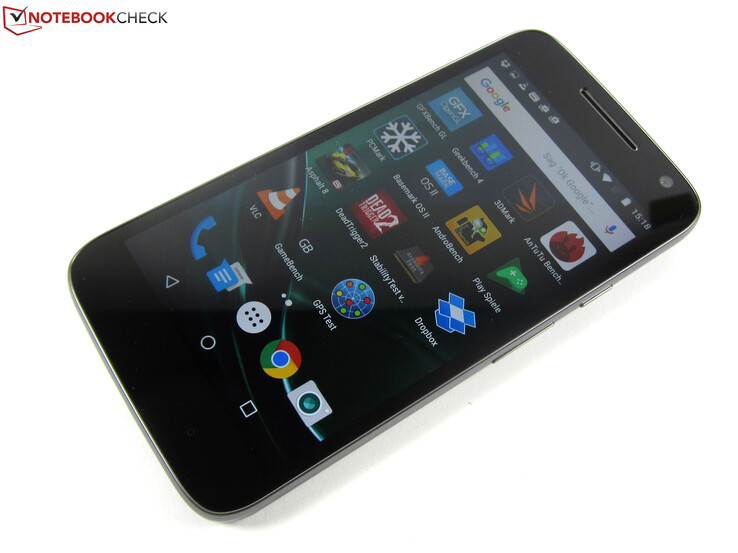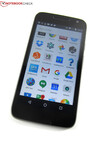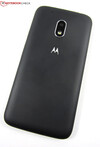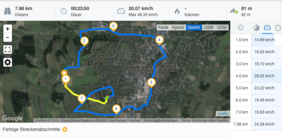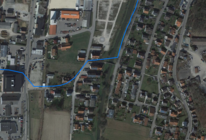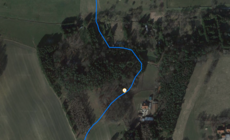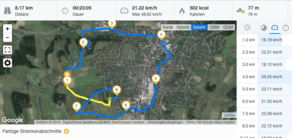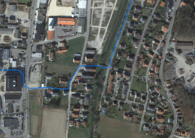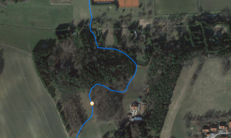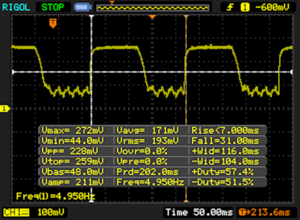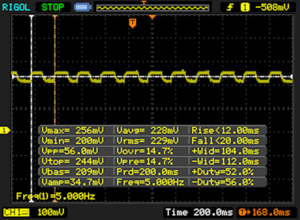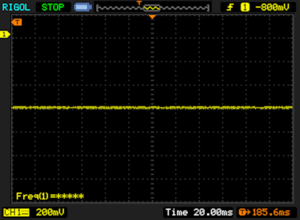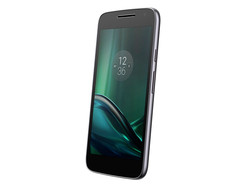Breve Análise do Smartphone Lenovo Moto G4 Play
Os Top 10
» Os Top 10 Portáteis Multimídia
» Os Top 10 Portáteis de Jogos
» Os Top 10 Portáteis Leves para Jogos
» Os Top 10 Portáteis Acessíveis de Escritório/Empresariais
» Os Top 10 Portáteis Premium de Escritório/Empresariais
» Os Top 10 dos Portáteis Workstation
» Os Top 10 Subportáteis
» Os Top 10 Ultrabooks
» Os Top 10 Conversíveis
» Os Top 10 Tablets
» Os Top 10 Smartphones
» A melhores Telas de Portáteis Analisadas Pela Notebookcheck
» Top 10 dos portáteis abaixo dos 500 Euros da Notebookcheck
» Top 10 dos Portáteis abaixo dos 300 Euros
Size Comparison
| SD Card Reader | |
| maximum SDCardreader Maximum Transfer Rate | |
| average SDCardreader Average Transfer Rate |
| Networking | |
| iperf Server (receive) TCP 1 m | |
| Sony Xperia XA | |
| Lenovo Moto G4 Play | |
| iperf Client (transmit) TCP 1 m | |
| Sony Xperia XA | |
| Lenovo Moto G4 Play | |
| |||||||||||||||||||||||||
iluminação: 94 %
iluminação com acumulador: 412 cd/m²
Contraste: 981:1 (Preto: 0.42 cd/m²)
ΔE ColorChecker Calman: 5.6 | ∀{0.5-29.43 Ø4.78}
ΔE Greyscale Calman: 6.9 | ∀{0.09-98 Ø5}
96.7% sRGB (Calman 2D)
Gamma: 2.4
CCT: 8422 K
| Lenovo Moto G4 Play IPS, 1280x720, 5" | Asus ZenFone Max ZC550KL IPS, 1280x720, 5.5" | HTC One A9 AMOLED, 1920x1080, 5" | Samsung Galaxy J5 2016 AMOLED, 1280x720, 5.2" | Sony Xperia XA IPS, 1280x720, 5" | Motorola Moto G 3. Gen 2015 XT1541 IPS, 1280x720, 5" | |
|---|---|---|---|---|---|---|
| Screen | 11% | 22% | 7% | -9% | 6% | |
| Brightness middle (cd/m²) | 412 | 586 42% | 346 -16% | 289 -30% | 518 26% | 418 1% |
| Brightness (cd/m²) | 414 | 566 37% | 349 -16% | 291 -30% | 475 15% | 407 -2% |
| Brightness Distribution (%) | 94 | 84 -11% | 93 -1% | 96 2% | 81 -14% | 95 1% |
| Black Level * (cd/m²) | 0.42 | 0.57 -36% | 0.61 -45% | 0.49 -17% | ||
| Contrast (:1) | 981 | 1028 5% | 849 -13% | 853 -13% | ||
| Colorchecker dE 2000 * | 5.6 | 4.2 25% | 1.55 72% | 4.7 16% | 6.8 -21% | 3.92 30% |
| Colorchecker dE 2000 max. * | 9.7 | 8.4 13% | 7.3 25% | 11.4 -18% | ||
| Greyscale dE 2000 * | 6.9 | 6.3 9% | 2.05 70% | 3 57% | 7 -1% | 3.81 45% |
| Gamma | 2.4 92% | 2.39 92% | 2.15 102% | 2.03 108% | 2.35 94% | 2.27 97% |
| CCT | 8422 77% | 6614 98% | 6267 104% | 6291 103% | 8151 80% | 7361 88% |
* ... menor é melhor
Exibir tempos de resposta
| ↔ Tempo de resposta preto para branco | ||
|---|---|---|
| 38 ms ... ascensão ↗ e queda ↘ combinadas | ↗ 7 ms ascensão | |
| ↘ 31 ms queda | ||
| A tela mostra taxas de resposta lentas em nossos testes e será insatisfatória para os jogadores. Em comparação, todos os dispositivos testados variam de 0.1 (mínimo) a 240 (máximo) ms. » 96 % de todos os dispositivos são melhores. Isso significa que o tempo de resposta medido é pior que a média de todos os dispositivos testados (20.2 ms). | ||
| ↔ Tempo de resposta 50% cinza a 80% cinza | ||
| 32 ms ... ascensão ↗ e queda ↘ combinadas | ↗ 12 ms ascensão | |
| ↘ 20 ms queda | ||
| A tela mostra taxas de resposta lentas em nossos testes e será insatisfatória para os jogadores. Em comparação, todos os dispositivos testados variam de 0.165 (mínimo) a 636 (máximo) ms. » 42 % de todos os dispositivos são melhores. Isso significa que o tempo de resposta medido é semelhante à média de todos os dispositivos testados (31.6 ms). | ||
Cintilação da tela / PWM (modulação por largura de pulso)
| Tela tremeluzindo / PWM não detectado | |||
[pwm_comparison] Em comparação: 53 % de todos os dispositivos testados não usam PWM para escurecer a tela. Se PWM foi detectado, uma média de 8111 (mínimo: 5 - máximo: 343500) Hz foi medida. | |||
| AnTuTu v6 - Total Score (classificar por valor) | |
| Lenovo Moto G4 Play | |
| Asus ZenFone Max ZC550KL | |
| Samsung Galaxy J5 2016 | |
| Sony Xperia XA | |
| GFXBench (DX / GLBenchmark) 2.7 | |
| T-Rex Onscreen (classificar por valor) | |
| Lenovo Moto G4 Play | |
| HTC One A9 | |
| Samsung Galaxy J5 2016 | |
| Sony Xperia XA | |
| Motorola Moto G 3. Gen 2015 XT1541 | |
| 1920x1080 T-Rex Offscreen (classificar por valor) | |
| Lenovo Moto G4 Play | |
| Asus ZenFone Max ZC550KL | |
| HTC One A9 | |
| Samsung Galaxy J5 2016 | |
| Sony Xperia XA | |
| Motorola Moto G 3. Gen 2015 XT1541 | |
| GFXBench 3.0 | |
| on screen Manhattan Onscreen OGL (classificar por valor) | |
| Lenovo Moto G4 Play | |
| Asus ZenFone Max ZC550KL | |
| HTC One A9 | |
| Samsung Galaxy J5 2016 | |
| Sony Xperia XA | |
| Motorola Moto G 3. Gen 2015 XT1541 | |
| 1920x1080 1080p Manhattan Offscreen (classificar por valor) | |
| Lenovo Moto G4 Play | |
| Asus ZenFone Max ZC550KL | |
| HTC One A9 | |
| Samsung Galaxy J5 2016 | |
| Sony Xperia XA | |
| Motorola Moto G 3. Gen 2015 XT1541 | |
| GFXBench 3.1 | |
| on screen Manhattan ES 3.1 Onscreen (classificar por valor) | |
| HTC One A9 | |
| Samsung Galaxy J5 2016 | |
| Sony Xperia XA | |
| 1920x1080 Manhattan ES 3.1 Offscreen (classificar por valor) | |
| HTC One A9 | |
| Samsung Galaxy J5 2016 | |
| Sony Xperia XA | |
| PCMark for Android - Work performance score (classificar por valor) | |
| Lenovo Moto G4 Play | |
| Asus ZenFone Max ZC550KL | |
| HTC One A9 | |
| Samsung Galaxy J5 2016 | |
| Sony Xperia XA | |
| Motorola Moto G 3. Gen 2015 XT1541 | |
| Octane V2 - Total Score (classificar por valor) | |
| Lenovo Moto G4 Play | |
| Asus ZenFone Max ZC550KL | |
| HTC One A9 | |
| Samsung Galaxy J5 2016 | |
| Sony Xperia XA | |
| Motorola Moto G 3. Gen 2015 XT1541 | |
| Mozilla Kraken 1.1 - Total (classificar por valor) | |
| Lenovo Moto G4 Play | |
| Asus ZenFone Max ZC550KL | |
| HTC One A9 | |
| Samsung Galaxy J5 2016 | |
| Sony Xperia XA | |
| Motorola Moto G 3. Gen 2015 XT1541 | |
| WebXPRT 2015 - Overall (classificar por valor) | |
| Lenovo Moto G4 Play | |
| HTC One A9 | |
| Samsung Galaxy J5 2016 | |
| Sony Xperia XA | |
| Motorola Moto G 3. Gen 2015 XT1541 | |
| JetStream 1.1 - Total Score (classificar por valor) | |
| Lenovo Moto G4 Play | |
| Asus ZenFone Max ZC550KL | |
| HTC One A9 | |
| Samsung Galaxy J5 2016 | |
| Sony Xperia XA | |
| Motorola Moto G 3. Gen 2015 XT1541 | |
* ... menor é melhor
| Asphalt 8: Airborne | |||
| Configurações | Valor | ||
| high | 29 fps | ||
| very low | 29 fps | ||
| Dead Trigger 2 | |||
| Configurações | Valor | ||
| high | 60 fps | ||
(+) A temperatura máxima no lado superior é 38.8 °C / 102 F, em comparação com a média de 35.2 °C / 95 F , variando de 21.9 a 247 °C para a classe Smartphone.
(+) A parte inferior aquece até um máximo de 35.6 °C / 96 F, em comparação com a média de 34 °C / 93 F
(+) Em uso inativo, a temperatura média para o lado superior é 30 °C / 86 F, em comparação com a média do dispositivo de 32.9 °C / ### class_avg_f### F.
Lenovo Moto G4 Play análise de áudio
(-) | alto-falantes não muito altos (###valor### dB)
Graves 100 - 315Hz
(-) | quase nenhum baixo - em média 24% menor que a mediana
(±) | a linearidade dos graves é média (10.4% delta para a frequência anterior)
Médios 400 - 2.000 Hz
(±) | médios reduzidos - em média 5% menor que a mediana
(±) | a linearidade dos médios é média (7.6% delta para frequência anterior)
Altos 2 - 16 kHz
(+) | agudos equilibrados - apenas 3.6% longe da mediana
(+) | os máximos são lineares (3.7% delta da frequência anterior)
Geral 100 - 16.000 Hz
(±) | a linearidade do som geral é média (25% diferença em relação à mediana)
Comparado com a mesma classe
» 61% de todos os dispositivos testados nesta classe foram melhores, 7% semelhantes, 33% piores
» O melhor teve um delta de 11%, a média foi 35%, o pior foi 134%
Comparado com todos os dispositivos testados
» 76% de todos os dispositivos testados foram melhores, 5% semelhantes, 19% piores
» O melhor teve um delta de 4%, a média foi 24%, o pior foi 134%
Asus ZenFone Max ZC550KL análise de áudio
(+) | os alto-falantes podem tocar relativamente alto (###valor### dB)
Graves 100 - 315Hz
(-) | quase nenhum baixo - em média 40.1% menor que a mediana
(±) | a linearidade dos graves é média (7.5% delta para a frequência anterior)
Médios 400 - 2.000 Hz
(±) | médios reduzidos - em média 6.2% menor que a mediana
(±) | a linearidade dos médios é média (12.1% delta para frequência anterior)
Altos 2 - 16 kHz
(±) | máximos mais altos - em média 5.8% maior que a mediana
(+) | os máximos são lineares (4.8% delta da frequência anterior)
Geral 100 - 16.000 Hz
(-) | o som geral não é linear (30.4% diferença em relação à mediana)
Comparado com a mesma classe
» 79% de todos os dispositivos testados nesta classe foram melhores, 4% semelhantes, 18% piores
» O melhor teve um delta de 11%, a média foi 35%, o pior foi 134%
Comparado com todos os dispositivos testados
» 88% de todos os dispositivos testados foram melhores, 3% semelhantes, 9% piores
» O melhor teve um delta de 4%, a média foi 24%, o pior foi 134%
Samsung Galaxy J5 2016 análise de áudio
(+) | os alto-falantes podem tocar relativamente alto (###valor### dB)
Graves 100 - 315Hz
(-) | quase nenhum baixo - em média 32.6% menor que a mediana
(±) | a linearidade dos graves é média (7.1% delta para a frequência anterior)
Médios 400 - 2.000 Hz
(±) | médios mais altos - em média 7.6% maior que a mediana
(±) | a linearidade dos médios é média (10.9% delta para frequência anterior)
Altos 2 - 16 kHz
(±) | máximos mais altos - em média 6.1% maior que a mediana
(+) | os máximos são lineares (6.5% delta da frequência anterior)
Geral 100 - 16.000 Hz
(-) | o som geral não é linear (30.2% diferença em relação à mediana)
Comparado com a mesma classe
» 78% de todos os dispositivos testados nesta classe foram melhores, 4% semelhantes, 18% piores
» O melhor teve um delta de 11%, a média foi 35%, o pior foi 134%
Comparado com todos os dispositivos testados
» 88% de todos os dispositivos testados foram melhores, 3% semelhantes, 9% piores
» O melhor teve um delta de 4%, a média foi 24%, o pior foi 134%
Sony Xperia XA análise de áudio
(+) | os alto-falantes podem tocar relativamente alto (###valor### dB)
Graves 100 - 315Hz
(-) | quase nenhum baixo - em média 24.9% menor que a mediana
(±) | a linearidade dos graves é média (7.9% delta para a frequência anterior)
Médios 400 - 2.000 Hz
(±) | médios mais altos - em média 5.3% maior que a mediana
(±) | a linearidade dos médios é média (9.3% delta para frequência anterior)
Altos 2 - 16 kHz
(±) | máximos mais altos - em média 10.7% maior que a mediana
(±) | a linearidade dos máximos é média (7% delta para frequência anterior)
Geral 100 - 16.000 Hz
(±) | a linearidade do som geral é média (29.3% diferença em relação à mediana)
Comparado com a mesma classe
» 76% de todos os dispositivos testados nesta classe foram melhores, 4% semelhantes, 20% piores
» O melhor teve um delta de 11%, a média foi 35%, o pior foi 134%
Comparado com todos os dispositivos testados
» 87% de todos os dispositivos testados foram melhores, 3% semelhantes, 11% piores
» O melhor teve um delta de 4%, a média foi 24%, o pior foi 134%
| desligado | |
| Ocioso | |
| Carga |
|
Key:
min: | |
| Lenovo Moto G4 Play 2800 mAh | Asus ZenFone Max ZC550KL 5000 mAh | HTC One A9 mAh | Samsung Galaxy J5 2016 3100 mAh | Sony Xperia XA 2300 mAh | Motorola Moto G 3. Gen 2015 XT1541 mAh | |
|---|---|---|---|---|---|---|
| Power Consumption | -50% | -12% | 14% | -11% | 18% | |
| Idle Minimum * (Watt) | 0.68 | 1.15 -69% | 0.9 -32% | 0.61 10% | 0.72 -6% | 0.4 41% |
| Idle Average * (Watt) | 1.58 | 2.09 -32% | 1.2 24% | 1.41 11% | 1.5 5% | 1 37% |
| Idle Maximum * (Watt) | 1.61 | 2.17 -35% | 1.4 13% | 1.51 6% | 1.57 2% | 1.2 25% |
| Load Average * (Watt) | 3.36 | 5.38 -60% | 3.8 -13% | 2.56 24% | 3.48 -4% | 2.9 14% |
| Load Maximum * (Watt) | 3.91 | 6.08 -55% | 5.9 -51% | 3.1 21% | 6.04 -54% | 5 -28% |
* ... menor é melhor
| Lenovo Moto G4 Play 2800 mAh | Asus ZenFone Max ZC550KL 5000 mAh | HTC One A9 mAh | Samsung Galaxy J5 2016 3100 mAh | Sony Xperia XA 2300 mAh | Motorola Moto G 3. Gen 2015 XT1541 mAh | |
|---|---|---|---|---|---|---|
| Duração da bateria | 52% | -40% | 2% | -46% | -16% | |
| Reader / Idle (h) | 33.3 | 19.2 -42% | 26.7 -20% | 12.9 -61% | 22.7 -32% | |
| H.264 (h) | 11.4 | 7.8 -32% | 11 -4% | 7.7 -32% | 11.3 -1% | |
| WiFi v1.3 (h) | 10.5 | 16 52% | 6.1 -42% | 10.7 2% | 5.9 -44% | 8.8 -16% |
| Load (h) | 5.1 | 2.9 -43% | 6.7 31% | 2.8 -45% | 4.4 -14% |
Pro
Contra
"Motorola entrega um smartphone de gama média com o Moto G, com recursos especiais e impressionantes." Esta frase foi o veredicto do Moto G de 3ra geração. Nós podemos aplicá-la diretamente para o Moto G4. O modelo de teste combina bom hardware e um desempenho sólido, sem grandes falhas. Em comparação com o predecessor, o Moto G4 tem um SoC mais veloz, mais espeço de armazenamento, uma tela similar, mas com preço mais baixo. Se você deseja um smartphone barato, porém, bom, recomendamos pagar 159 Euros (~$174) pelo Moto G4 Play.
O Lenovo Moto G4 Play é um aparelho bastante completo de gama média com fortalezas específicas por um preço relativamente baixo.
O telefone tem algumas falhas: o alto falante é relativamente silencioso e as câmeras não impressionarão o usuário. Não suporta NFC e o conteúdo da tela somente pode ser transmitido para uma TV utilizando o Chromecast. Nós também sentimos falta do cabo Micro-USB separado.
Lenovo Moto G4 Play
- 11/01/2016 v5.1 (old)
Manuel Masiero




